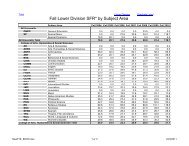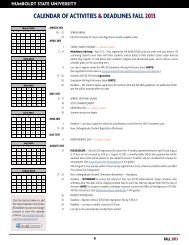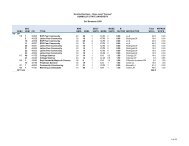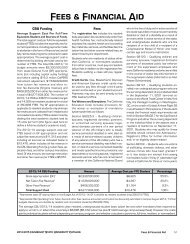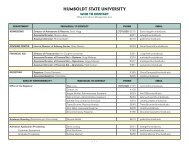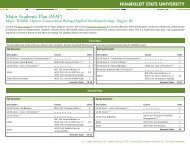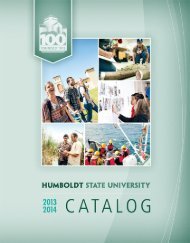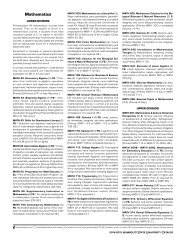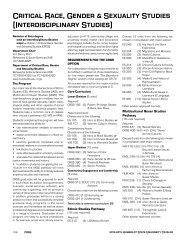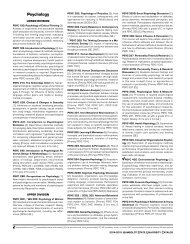2007-08 Academic Year - Humboldt State University
2007-08 Academic Year - Humboldt State University
2007-08 Academic Year - Humboldt State University
Create successful ePaper yourself
Turn your PDF publications into a flip-book with our unique Google optimized e-Paper software.
Graduate Study Deadlines<br />
For fall semester admission, apply after<br />
October 1. For spring semester admission,<br />
apply after August 1. Deadlines for submitting<br />
graduate applications vary by department.<br />
Check with Research and Graduate<br />
Studies, (707) 826-3949, or the individual<br />
department office. While some admission<br />
categories remain open later than others, no<br />
applications will be accepted later than one<br />
month prior to the beginning of the term.<br />
Graduate Financial Aid<br />
Placement in one or another of the postbaccalaureate<br />
admission categories has an<br />
effect on student eligibility for financial aid.<br />
Contact the Financial Aid office, (707) 826-<br />
4321, for clarification of eligibility.<br />
Graduate Study Procedures<br />
1. Apply for and gain admission to <strong>Humboldt</strong><br />
<strong>State</strong> <strong>University</strong>.<br />
2. Consult with the graduate advisor in your<br />
area of intended study and prepare a<br />
tentative course schedule.<br />
3. After completing 15 units or at least<br />
one semester of graduate work, apply<br />
for advancement to candidacy for the<br />
master’s degree. The graduate office,<br />
129 Siemens Hall, has the necessary<br />
forms. They are also available on the<br />
Web at www.humboldt.edu/~gradst/.<br />
After completing them and obtaining the<br />
approval of your advisor, committee and<br />
graduate coordinator, return the forms<br />
to the graduate office for processing.<br />
Advancement to candidacy requires:<br />
• a suitable amount of appropriate<br />
course work (upper division and graduate)<br />
with a GPA of 3.0 or better.<br />
• satisfactory performance on any<br />
comprehensive or qualifying exam<br />
required by the department;<br />
• approval by departmental committee<br />
of an official program of study<br />
that meets all requirements for the<br />
degree;<br />
• approval of plan to use humans or<br />
animals as subjects for research, if<br />
applicable.<br />
Applications for advancement to candidacy<br />
must be complete and on file in the graduate<br />
office before filing the graduate application<br />
for graduation.<br />
Graduate Degree Requirements<br />
General requirements for the master’s<br />
degree programs follow. Discipline specific<br />
requirements are outlined in the program<br />
description section of this catalog.<br />
1. Complete a specified program of study,<br />
usually requiring approval from the university<br />
department.<br />
2. Complete a minimum of 30 semester<br />
units of approved upper division and<br />
graduate courses within a set time. All<br />
degree requirements must be met within<br />
a maximum of seven years. An extension<br />
beyond this time limit may be granted if<br />
circumstances warrant. This standard<br />
includes:<br />
• no less than 21 semester units at<br />
<strong>Humboldt</strong> (residency requirement)<br />
unless an exception is made;<br />
• not less than half the units required for<br />
the degree in courses specifically for<br />
graduate students, 500-600 level;<br />
• no more than six units for a thesis or<br />
project;<br />
• a maximum of nine units of independent<br />
study, field work, or thesis /project<br />
courses.<br />
3. Satisfactorily complete a thesis, project,<br />
or comprehensive examination as defined<br />
below. It is the student’s responsibility<br />
to determine from his/her advisor the<br />
departmental policy on theses, projects,<br />
or comprehensive exams.<br />
• A thesis is the written product of a<br />
systematic study of a significant problem.<br />
It identifies the problem, states major<br />
assumptions, explains the significance<br />
of the undertaking, sets forth sources<br />
for and methods of gathering information,<br />
analyzes the data, and offers a conclusion<br />
or recommendation. The finished<br />
product evidences originality, critical<br />
and independent thinking, appropriate<br />
organization and format, and thorough<br />
documentation. Usually it will require an<br />
oral defense.<br />
• A project is a significant undertaking<br />
appropriate to the fine and applied arts<br />
or to professional fields. It evidences<br />
originality and independent thinking, appropriate<br />
form and organization, and a<br />
rationale. A written abstract summarizes<br />
and describes the project’s significance,<br />
objectives, methodology, and conclusions<br />
or recommendations. An oral defense<br />
may be required. Projects are treated<br />
in one of two ways. Some projects are<br />
described thoroughly in a manuscript,<br />
bound, and placed in the <strong>Humboldt</strong><br />
<strong>State</strong> <strong>University</strong> library. These projects<br />
are referred to as “bound projects”<br />
and must meet the manuscript format<br />
requirements of the thesis. An unbound<br />
project is a project that cannot be bound,<br />
for example, a theatre lighting project.<br />
Unbound projects are governed by regulations<br />
specific to the program in which<br />
they originate. Departments or colleges<br />
are responsible for archiving the projects<br />
and for maintaining permanent record of<br />
the projects.<br />
• A comprehensive examination assesses<br />
a student’s ability to integrate knowledge<br />
of the area, show independent<br />
and critical thinking, and demonstrate<br />
mastery of the subject matter. The results<br />
evidence independent thinking, appropriate<br />
organization, critical analysis,<br />
and accuracy of documentation. Examination<br />
questions and responses are kept<br />
according to the CSU records retention<br />
policy.<br />
4. Maintain a grade-point average of 3.0 (B)<br />
or better in all courses taken to satisfy<br />
degree requirements. Courses in which<br />
no letter grade is assigned are not used<br />
in computing GPA.<br />
5. The California <strong>State</strong> <strong>University</strong>, under Executive<br />
Order 665, requires that graduate<br />
students demonstrate competency<br />
in writing. The compliance methods for<br />
the various programs are listed in the<br />
“Handbook for Master’s Students,” see<br />
Graduate Writing Requirement. (www.<br />
humboldt.edu/~gradst/; click on “Currently<br />
Enrolled Students”)<br />
6. To graduate, be in good standing (maintain<br />
a 3.0 overall GPA).<br />
7. File the graduate student application for<br />
graduation at least one semester before<br />
finishing all degree requirements. A current<br />
schedule of classes has appropriate<br />
deadlines.<br />
Continuous Enrollment<br />
Students admitted to master’s degree programs<br />
are required to enroll for a minimum<br />
of one unit per term for at least two terms<br />
per academic year (fall, spring, summer)<br />
until their degree requirements are completed.<br />
Master’s degree students who do not<br />
maintain continuous enrollment (two terms<br />
each academic year), and who have not been<br />
granted a leave of absence are required to<br />
reapply for admission to the university and<br />
to the graduate program. Thus, students will<br />
be subject to any new admission or degree<br />
requirements that have been approved since<br />
52 Planning Your Master’s Degree<br />
<strong>2007</strong>-20<strong>08</strong> <strong>Humboldt</strong> <strong>State</strong> <strong>University</strong> Catalog



